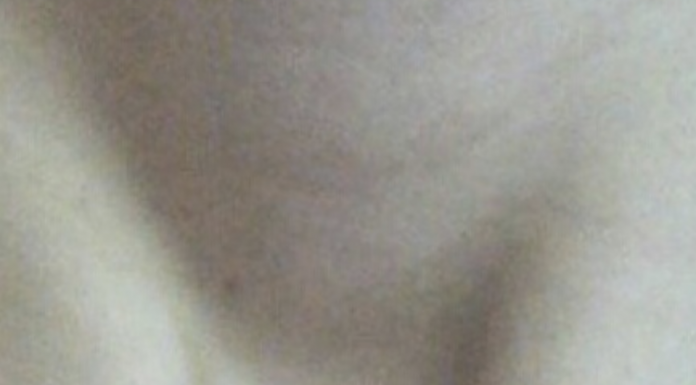Is this what ‘the new normal’ looks like? |
It looks like a Band-Aid (R), but it’s a flexible wireless sensor that sits where your throat and chest meet, picking up coughing and breathing problems associated with COVID-19.
The device, announced Monday, can monitor early signs of coronavirus infection and the progression of the illness.
Developed in hard-hit Chicago by Northwestern University and the Shirley Ryan AbilityLab, the device adheres to the skin below your suprasternal notch — the little well at the base of your throat where airflow is closest to the skin and where tracheostomies are also performed.
This patch, however, is non-invasive and is related to a sensor for monitoring speech and swallowing in recovering stroke patients. That design was tuned to track coughing and breathing problems that are central to COVID-19.
“We don’t use a microphone,” says Professor John Rogers, director of Northwestern University’s Center on Bio-Integrated Electronics. “There are problems with microphones with ambient noise and tremendous invasions of privacy.
We use a high-bandwidth, tri-axis accelerometer to measure movement of the surface of the skin” to capture details of breathing and coughing, not unlike a digital stethoscope.
The patch also detects heart rate and temperature.
Once a day you peel it off and place it on a wireless charger, which triggers the patch to sync its stored data with a nearby iPad. From there the data is uploaded to a HIPAA-compliant cloud where a proprietary AI algorithm examines it for anomalies related to COVID-19.
The device has no external ports for power or connectivity, making it easier to disinfect … Read more.
Monitoring COVID-19 from hospital to home
First wearable device continuously tracks key symptoms
Wireless sensor gently sits on throat to monitor coughs, fever and respiratory activity
May 04, 2020
Northwestern Now
EVANSTON, Ill. — The more we learn about the novel coronavirus (COVID-19), the more unknowns seem to arise.

These ever-emerging mysteries highlight the desperate need for more data to help researchers and physicians better understand — and treat — the extremely contagious and deadly disease.
Researchers at Northwestern University and Shirley Ryan AbilityLab in Chicago have developed a novel wearable device and are creating a set of data algorithms specifically tailored to catch early signs and symptoms associated with COVID-19 and to monitor patients as the illness progresses.
Capable of being worn 24/7, the device produces continuous streams of data and uses artificial intelligence to uncover subtle, but potentially life-saving, insights.
Filling a vital data gap, it continuously measures and interprets coughing and respiratory activity in ways that are impossible with traditional monitoring systems.
Developed in an engineering laboratory at Northwestern and using custom algorithms being created by Shirley Ryan AbilityLab scientists, the devices are currently being used at Shirley Ryan AbilityLab by COVID-19 patients and the healthcare workers who treat them. About 25 affected individuals began using the devices two weeks ago.
They are being monitored both in the clinic and at home, totaling more than 1,500 cumulative hours and generating more than one terabyte of data.
About the size of a postage stamp, the soft, flexible, wireless, thin device sits just below the suprasternal notch — the visible dip at the base of the throat. From this location, the device monitors coughing intensity and patterns, chest wall movements (which indicate labored or irregular breathing), respiratory sounds, heart rate and body temperature, including fever.
From there, it wirelessly transmits data to a HIPAA-protected cloud, where automated algorithms produce graphical summaries tailored to facilitate rapid, remote monitoring.
“The most recent studies published in the Journal of the American Medical Association suggest that the earliest signs of a COVID-19 infection are fever, coughing and difficulty in breathing. Our device sits at the perfect location on the body — the suprasternal notch — to measure respiratory rate, sounds and activity because that’s where airflow occurs near the surface of the skin,” said Northwestern’s John A. Rogers, who led the technology development.
“We developed customized devices, data algorithms, user interfaces and cloud-based data systems in direct response to specific needs brought to us by frontline healthcare workers. We’re fully engaged in contributing our expertise in bioelectronic engineering to help address the pandemic, using technologies that we are able to deploy now, for immediate use on actual patients and other affected individuals. The measurement capabilities are unique to this device platform — they cannot be accomplished using traditional watch or ring-style wearables that mount on the wrist or the finger.”
“We anticipate that the advanced algorithms we are developing will extract COVID-like signs and symptoms from the raw data insights and symptoms even before individuals may perceive them,” said Arun Jayaraman, a research scientist at Shirley Ryan AbilityLab, who is leading the algorithm development. “These sensors have the potential to unlock information that will protect frontline medical workers and patients alike — informing interventions in a timely manner to reduce the risk of transmission and increase the likelihood of better outcomes.”
Continuous monitoring from hospital to home
The mysterious ways that COVID-19 affects the body seem to get stranger and stranger. Many patients’ symptoms fully disappear before they suddenly and unexpectedly begin deteriorating — sometimes within a matter of hours. Other patients have recovered and tested “negative” but later test “positive” again. Read more.



